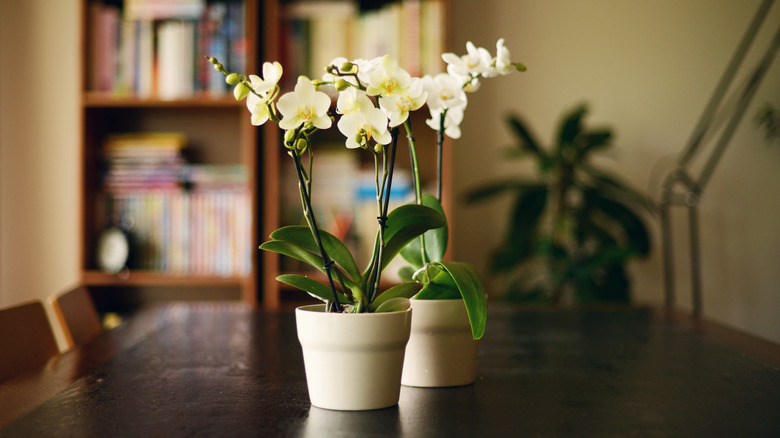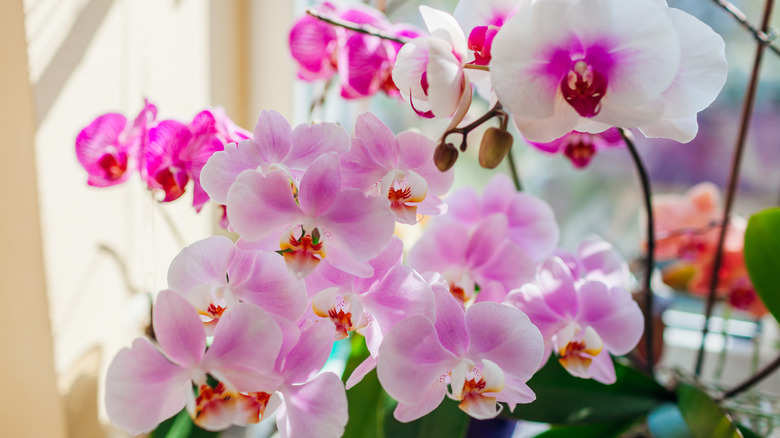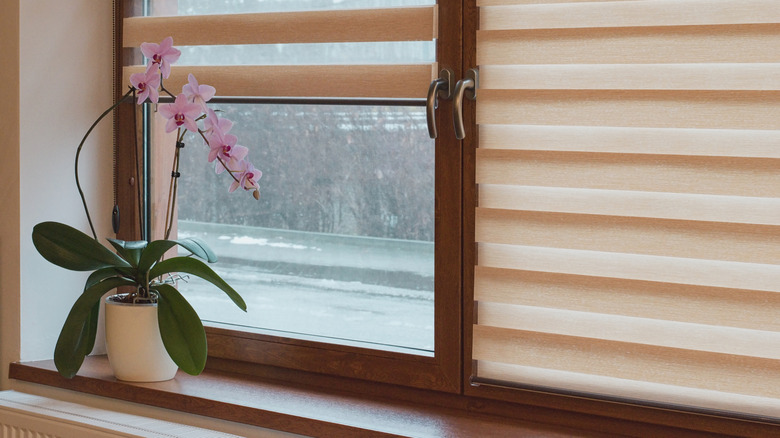If Your Orchid Isn't Blooming, You Might Be Making This Easy-To-Fix Mistake
When you're grocery shopping, it can be hard to deny the beautiful display of orchids calling your name. Well-known as plants that only need a few servings of ice cubes to thrive, houseplant lovers soon realize how finicky these tropical plants can be. Not only is the best method for watering orchids actually to give them a good soak, but there are other often unknown orchid requirements necessary for producing the best blooms. That said, providing the proper care for orchids depends on the variety you have. After all, there are about 28,000 known orchid species, all with their own unique needs. The most common is the moth orchid (Phalaenopsis amabilis), which is typically what you see lining the shelves at grocery stores.
Thankfully, there are a couple of easy ways to tweak your orchid care so that you get more exotic-looking blooms. Native to southeastern Asia and parts of Australia, these fleshy flowers are a little particular about the environment they live in. Orchids are hardy when grown outdoors in zones 10-12, so it's no surprise they thrive in warm, humid conditions. Luckily, you have a bit more control over the temperature when caring for these flowers as houseplants, no matter where you live. If your orchids aren't blooming the way they should be, there are a few simple tweaks you can make to get them looking their best again.
Keep orchids in their preferred temperature range for the best blooms
Mimicking an orchid's natural environment is the key to having a healthy plant with more blooms. Depending on the species, an orchid may be in one of three categories: warm, intermediate, or cool. Moth orchids, for example, fall into the intermediate-warm group and thrive when daytime temperatures are between 70 and 80 degrees Fahrenheit. In addition to decreased blooms, you'll know your orchids are overheated if they're warm to the touch or have yellowing leaves. If your plant is too cold, it may have drooping, blackening, or curling leaves, and sudden temperature drops can cause bud damage.
Another common mistake that is sure to kill your orchid is placing it in an environment that experiences rapid temperature changes. Don't keep your plants near vents or other areas that could cause the air around them to get too warm or too cool quickly. Placing orchids away from radiators, air conditioning units, or vents can help prevent exposure to extreme climate changes. Additionally, using cold water can shock the roots and may even damage them. Instead, opt for lukewarm or room-temperature water. On the other hand, orchids can get sunburnt, showing up as spots of red or brown on the leaves and even scorched blooms. Moth orchids like bright, indirect sunlight, so make sure your plants are in an area that keeps them protected against the harsh rays.
Relocate your orchids at night
Not only do orchids need specific daytime temperatures, but they also have nighttime preferences. To successfully care for indoor orchids, make sure their environment is slightly cooler at night. During the day, orchids undergo the same process as all plants: photosynthesis. They spend sunlit hours making food and consuming the energy in a process called respiration, which is essential for healthy flower growth. Because respiration rates increase in higher temperatures, they need cooler temperatures to prevent consuming more energy than they're able to produce. Without dropping down the thermostat at night, your orchids may not have enough energy to produce blooms properly.
To keep your houseplant healthy, make sure the temperature drops by 10-15 degrees Fahrenheit at night. The easiest way to do this is to turn down your thermostat, and luckily, there are some benefits to cooler bedtime temperatures for us, too. If you don't want to live in the same conditions as your orchids, it may help to keep them outside during the day and bring them inside at night during the summer. You may also place them in a room that tends to cool down at night, such as a bathroom or basement, once the sun goes down. Inadequate daytime to nighttime temperature shifts are among the most common reasons orchids may fail to bloom, so adjust accordingly and watch the magic happen!


